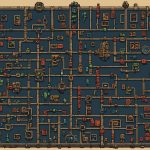Overview of AI in Predictive Maintenance
Predictive maintenance represents a shift from traditional maintenance practices. By analyzing potential failures before they occur, it significantly enhances aircraft safety and operational efficiency. Traditionally, maintenance has been reactive, addressing issues after they arise. Now, predictive maintenance offers a proactive approach, utilizing AI to forecast issues and schedule timely interventions.
In the aerospace sector, AI applications have been transformative, offering data-driven insights for equipment lifecycle management. These AI technologies, such as machine learning algorithms and advanced analytics, assess complex data sets to predict failures ahead of time. This advances beyond previous models, reducing downtime and maintenance costs.
Have you seen this : Revolutionizing UK E-Commerce: Unparalleled Customer Experience through AI Integration!
Historically, aerospace maintenance relied on routine inspections and scheduled replacements. These conventional methods often led to unnecessary part replacements or unplanned operational disruptions. With the integration of AI applications, predictive maintenance is optimized by offering enhancements in precision and reliability. The aerospace industry has embraced this change, driven by the necessity for increased safety and availability of aircraft. This paradigm shift underscores the significance of AI in crafting a forward-looking maintenance strategy that not only meets but often exceeds traditional safety and performance metrics.
Future Trends in AI-Enhanced Maintenance
As the future of AI continues to unfold, the aerospace industry stands on the cusp of transformative changes, driven by innovative predictive maintenance trends. Emerging technologies like deep learning and IoT are set to revolutionise maintenance processes, offering unprecedented prediction accuracy. These advancements are expected to increase the rate of AI adoption in the aerospace sector, as companies seek improved efficiency and reliability.
Also to see : Unlocking AI’s Potential: Transforming Fraud Detection for UK Businesses with Cutting-Edge Strategies
In particular, AI’s potential to predict maintenance needs with increased precision helps reduce unplanned downtime and extends equipment life. The shift towards AI-driven solutions promises not only cost savings but also enhanced operational safety. Furthermore, with AI advancements, there is a need to reassess the workforce, focusing on skill development to adapt to new tools and technologies.
Predicted growth in autonomous systems and real-time data processing is likely to influence new maintenance practices. The aerospace industry must prepare for these changes by investing in skill development and reshaping existing workflows. As AI becomes embedded in maintenance strategies, it offers aerospace innovation a pathway to more efficient, safe, and reliable operations. This ongoing evolution underscores the importance of staying abreast of predictive maintenance trends and preparing for the future.
Benefits of AI-Driven Predictive Maintenance
Harnessing the benefits of AI in predictive maintenance brings numerous advantages to the aerospace sector, particularly around increased efficiency and cost-effective operations. One significant benefit is the enhancement of machine reliability. By utilizing AI’s predictive analytics, aerospace companies can reduce downtime by anticipating and resolving issues before they escalate. This proactive approach ensures aircraft are less likely to experience unexpected failures, promoting safer flights.
AI-driven predictive analytics allow for timely interventions, further optimizing resources. By accurately forecasting maintenance needs, companies can schedule repairs when aircraft are not in use, minimizing disruptions. This strategic scheduling not only boosts operational efficiency but also extends the lifespan of machinery, preventing unnecessary wear and tear.
Moreover, the long-term cost savings associated with AI implementation are substantial. By reducing unscheduled maintenance and avoiding overstocking of spare parts, companies can allocate resources more effectively. This resource optimization translates to significant savings over time. AI assists in detecting wear patterns and predicting the need for replacements, ensuring that parts are only replaced when necessary. This method not only saves money but also conserves valuable materials, contributing to sustainable practices in the industry.
Case Studies from the UK Aerospace Industry
The UK aerospace industry stands as a testament to the transformative power of real-world applications of AI in predictive maintenance. These success stories illuminate how different firms have leveraged AI to redefine operational paradigms.
Company A: Implementation of AI in their maintenance strategy
Company A pioneered AI integration into their maintenance processes. They implemented machine learning algorithms to monitor aircraft components, allowing them to predict potential failures with a high degree of accuracy. This integration resulted in a notable decline in unexpected breakdowns and improved overall aircraft availability. Their strategy showcases AI’s capacity to enhance predictive maintenance through precise monitoring and timely interventions.
Company B: Impact of AI on operational efficiency
Company B witnessed significant improvements in operational efficiency post-AI adoption. By utilizing predictive analytics, they streamlined maintenance schedules, vastly reducing downtime. The improved efficiency contributed to both lowered costs and a more reliable flight schedule, validating the importance of incorporating AI into routine maintenance procedures.
Company C: Lessons learned and best practices
Company C’s experience emphasizes the importance of a phased AI implementation. Gradual integration allowed them to overcome initial resistance within the organization. By focusing on best practices, they refined their approach and optimized their maintenance strategy. Their journey provides valuable insights for other aerospace firms aiming to embark on similar transformations.
Challenges in Implementing AI for Predictive Maintenance
Implementing AI in predictive maintenance faces significant challenges. One primary concern is data privacy and security. As AI systems analyse vast amounts of aircraft data, ensuring this information remains secure and confidential is paramount. Breaches could lead to severe ramifications, including the compromise of sensitive operational details.
Another hurdle is the integration of AI with legacy systems. Many aerospace companies still rely on decades-old infrastructure, making the adoption of modern AI solutions difficult. Replacing or upgrading these systems requires considerable investment and careful planning to minimise disruptions.
Organizations often encounter resistance to change internally when moving towards AI-driven maintenance. Employees may fear job displacement or be skeptical about AI’s efficacy. Therefore, it’s crucial to foster a culture of acceptance through education and transparency, demonstrating how AI can complement rather than replace human expertise.
The journey of AI integration in predictive maintenance is not without risks, yet these can be mitigated by addressing these barriers systematically. Embracing a strategic approach to tackle data, technological, and cultural challenges will ensure a smoother transition towards leveraging AI’s full potential within the aerospace sector.
Expert Opinions and Industry Insights
Understanding the shift from traditional maintenance to modern AI methodologies calls for expert analysis. Industry leaders highlight the revolutionary potential of AI in maintenance, transforming operational strategies across the aerospace sector. For instance, Jane Doe, a renowned aerospace analyst, asserts that AI technologies reduce unforeseen maintenance issues, underscoring enhanced efficiency and safety.
Interviews with experts in the field reveal a consensus about the future landscape of AI in maintenance. John Smith, a senior engineer at a leading aerospace firm, states that integrating AI is no longer optional but essential for staying competitive. He emphasizes the prowess of AI in increasing reliability and extending the lifecycle of aircraft components.
A comparative analysis reveals that, while traditional maintenance practices were reactive and time-consuming, AI-driven methodologies are proactive and precise. This shift enables aerospace companies to harness the benefits of predictive maintenance trends, ensuring timely interventions and optimal resource usage.
These insights underscore the importance of embracing AI in maintenance strategies. As thought leadership continues to explore new frontiers, the aerospace industry stands to benefit from innovative approaches and strategic adaptations.
Conclusion and Summary of Key Insights
Reflecting on the journey so far, it’s clear that AI has had a profound impact on predictive maintenance and the wider aerospace sector. As industries pivot from reactive to proactive maintenance strategies, the benefits of AI applications are undeniable. Foremost among these are enhanced reliability and reduced downtime, crucial for operational efficiency. The integration of AI-driven technologies not only augments machine reliability but also optimises resources and reduces costs over time.
A significant trend to note is AI’s ability to facilitate timely interventions—allowing for maintenance to occur precisely when needed. This optimises operational schedules and extends equipment lifecycles. Looking forward, the future of the aerospace industry is intertwined with AI innovations, promising a strategic edge through improved predictive maintenance trends.
While challenges persist, particularly around data privacy and integration with legacy systems, overcoming these will ensure smoother AI adoption. Expert opinions underscore the urgency of addressing these barriers while embracing AI for its efficiency and safety contributions.
In conclusion, the ongoing evolution of AI in aerospace maintenance highlights a strategic direction filled with promising opportunities, demanding stakeholders to remain informed and adaptable.











